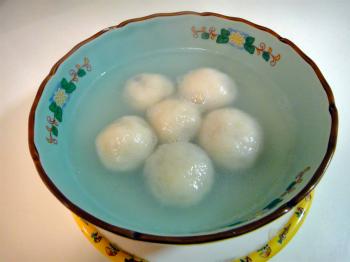The Lantern Festival is also called Yuanxiao Festival. It was on Feb. 17 this year. Last year, it was on Feb. 28, and next year it will be on Feb. 6. In 2007, it was as late as April 3.
Legends
There are many stories about the origin of the festival. One story is from the time of Qin Shihuang (259–210 B.C.), the first emperor to unite the country.
It was believed that the God of Heaven was born on the 15th day of the first month. Since the God of Heaven controlled the destiny of the human world and decided when to inflict drought, storms, famine, or pestilence upon human beings, the emperor would pray especially to the God of Heaven for favorable weather and good health on that day.
Another popular story is about Emperor Mingdi (A.D. 28–75) of the East Han Dynasty, who sent a scholar to India to get Buddhist scriptures.
After journeying thousands of miles, the scholar finally returned with the scriptures on the 15th day of the first month. The emperor was so pleased that he ordered people to display lighted lanterns on that night since it was said that the power of Buddha can dispel darkness.
Since then, all subsequent emperors ordered splendid ceremonies each year. The lantern displays would last for three days in the Tang Dynasty (A.D. 618–907) and five days in the Song Dynasty (A.D. 960–1279).
Subsequently, the festival became an important one that was celebrated together by people from all social classes. Many kinds of colorful glass and even jade were used to make lanterns with figures from folk tales painted on them.
Nowadays, the display of lanterns on the 15th day of the first lunar month is still a big event throughout China. It is the first night of the year for people to see a full moon.
At this time, many colorful lanterns are hung out for the occasion, and people enjoy the brightly lit night, which is an impressive sight. Family members gather together in a joyful atmosphere and eat Yuanxiao.
Story of Yuanxiao
Most Chinese people still call the Lantern Festival the Yuanxiao Festival. Yuanxiao is a small, round dumpling made of glutinous rice flour with various fillings.
Yuanxiao was originally the name of a palace maid who could make delicious dumplings for Emperor Wudi (156–87 B.C.). Once she entered the palace, she lost all contact with her parents and sisters, as it was forbidden for palace girls to be in touch with their families.
One day, she was so homesick that she cried in the garden. Minister Dong, who was picking some plum flowers for the emperor, saw her crying. Upon hearing her story, Dong promised to help her.
NEXT: Yuanxiao Dumplings
Their concerns were reported to Emperor Wudi, who became worried as well. He called all the ministers to the palace immediately and asked for advice. All the ministers were quiet, as they were too scared to come up with a solution.
Minister Dong suggested: “The god of fire likes to eat sweet dumpling balls. We can ask Yuanxiao to make some dumpling balls to serve him within a praying ceremony on the night before the 16th. All citizens should go out and light fireworks to drive away bad luck .
“With fireworks everywhere, it will look like we are on fire here. The Jade Emperor is very compassionate, and he might stop the god of fire from punishing us.” Emperor Wudi was very pleased with Dong’s suggestion and ordered following Dong’s advice.
The streets were very crowded with people on the evening of the 15th. Yuanxiao was on the street together with the other palace girls. Each one of them carried either a bowl of dumpling balls made by Yuanxiao or a long bamboo pole with a lantern hang up on one end.
When the girl’s parents and sisters saw the lanterns from the palace with the two characters for Yuanxiao, they became very excited and loudly called out her name. Following their calls, Yuanxiao found her parents and sisters, and the whole family was immediately reunited. Yuanxiao dumplings have become an important part of the Lantern Festival ever since.
Yuanxiao Dumplings
Yuanxiao dumplings are made in various ways in China. The fillings are either sweet or salty. In the old days, the dumplings were usually sweet, with fillings made from sugar, walnuts, sesame, rose petals, sweetened tangerine peel, red bean paste, date paste, lotus seed paste, or fruit paste. A single ingredient or any combination was used as filling. In modern days, a salty variety from minced meat, vegetables, or a mixture of both has been widely used.
The usual method followed in southern provinces is to shape the rice flour dough into balls, make a hole, insert the filling, close the hole, and smooth out the dumpling by rolling it between one’s hands.
In northern China, sweet or nonmeat stuffing is the usual ingredient. The fillings are pressed into hardened cores, dipped in water, and rolled in a flat basket containing dry glutinous rice flour. One rolls each dumpling, like rolling a snowball, until the ball reaches the desired size.








